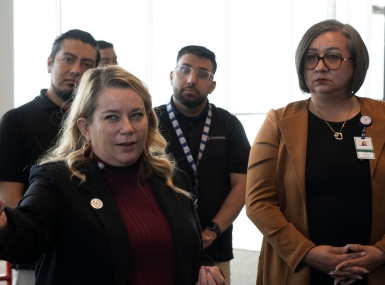U.S. Department of Agriculture increases school meal funding until end of academic year
Author

Rachel Mackey
Upcoming Events
Related News

Key Takeaways
On January 7, the U.S. Department of Agriculture (USDA) announced an increase in federal school meals reimbursements for 2022. While reimbursement rates for school meals do not typically change during the school year, USDA is using pandemic flexibilities to ensure additional funds are available. The increase will provide an estimated $750 million more to school meal programs this year, helping school food operations deal with increased costs and supply chain disruptions resulting from the COVID-19 pandemic. Counties applaud this infusion of federal resources to ensure children in our communities can access healthy food at school.
Through the National School Lunch Program (NSLP) and National School Breakfast Program (NSBP), USDA contributes funds to provide reduced-cost or free meals to millions of low-income children nationwide. In April 2021, USDA adopted a nationwide waiver for the 2021-2022 school year allowing schools to provide free meals to all students at the more generous reimbursement rates allotted for the Summer Food Service Program (SFSP), which operates separately during the summer months. SFSP rates are adjusted each January, and the most recent adjustment will apply to the NSLP and NSBP while they operate under the waiver, which expires June 30, 2022. As a result, schools will receive roughly 25 cents more per lunch and 14 cents more per breakfast compared to the 2021 SFSP rates.
Though the role of county governments in administering, operating and funding child nutrition programs varies, these programs support key county priorities such as improving early child development, combatting food insecurity, preventing child poverty and stimulating the local economy through the procurement process. Additionally, counties contribute funding to public schools in five states: Alaska, Maryland, North Carolina, Virginia. and Tenn. Counties support policies that ensure all children have access to healthy meals at no-cost in school, at child care and during the summer months.
NACo will continue to monitor administrative action on school meals and other child nutrition programs.
Advocacy
USDA moves to expand flexibility for schools to offer free school meals
On March 23, the U.S. Department of Agriculture proposed an expansion of the Community Eligibility Provision, an option by which schools with a sufficiently low-income population can offer free school meals to all students.

Related News

L.A. County fends off homelessness with an assist from A.I.
A predictive model pulls data from six county departments to create a list of the county’s most vulnerable population — people who frequently show up in the county’s criminal justice and hospital systems and who access benefits like SNAP.

El Paso County, Texas helps migrants on their way
Though they don't often stay more than a day, asylum seekers receive care and services from El Paso County, Texas before they leave for their next destination.
